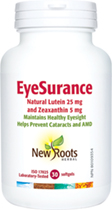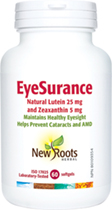For Your Eyes Only
When we look back at our ancestors, they were less concerned with heart disease, cancer, or the myriad of chronic diseases we are plagued with today. But they also did not have the lifespan we do now. As many of us live to see our 70s and 80s, perhaps our 90s or even our 100s, we want to ensure we can actually see these golden years. Macular degeneration, a disease associated with aging, could thwart this.
Macular Degeneration: A Progressive Eye Disease
It occurs mainly in those over age 50, smokers, diabetics, hypertensive, and those whose diet is high in processed foods. In early stages, there may not be any noticeable symptoms. As the disease progresses, there may be a central vision loss, low vision at night, lack of lustre in colour perception, and when looking at a straight line, it may appear wavy.
Unfortunately, in the early stage, there are no efficient conventional treatments, and your doctor may recommend a “wait-and-watch” approach. Then, in late-stage AMD, doctors resort to treatment with injection of drugs into the eye to slow it down.
So, How Do We Deal with AMD?
The key here is timing: Prevention with a healthy lifestyle, diet, and specific supplementation ensures that we consistently get enough micronutrients and protective compounds to keep our eyes at their best, at every age. A variety of vitamins, minerals, botanicals, and other nutraceuticals support ocular health and help prevent onset of crippling diseases.
What Are the Best Nutraceuticals for Eye Health?
Two of the best-known antioxidants for overall eye health are the carotenoids lutein and zeaxanthin. Carotenoids are found throughout the body’s tissues; yet, only lutein and zeaxanthin are found in the eye to protect it from sunlight damage.
Carotenoids are responsible for the yellow to orange colour in fruits and vegetables. About 600 carotenoids exist in nature. They can be divided into previtamin A, found in animal sources, and provitamin A, found in plant sources. Both can be converted into vitamin A in the body. Another category of carotenoid found in plants is non–provitamin A, such as lutein and zeaxanthin, which cannot be converted to vitamins in the body.[1] All carotenoids are essential as they cannot be produced by the human body, thus dietary consumption—or supplementation—are needed to prevent deficiency.
Can We Get Enough Lutein and Zeaxanthin from Our Diet?
It is uncertain. According to the Organic Consumers Association, several studies measuring the nutrient content of food from 1975 to 1997 found that overall nutrient level has dropped by significant amounts. Landmark research published in 2004 in the Journal of the American College of Nutrition mentions that between 1950 and 1999, the authors found “reliable declines” in the amount of protein, calcium, phosphorus, iron, riboflavin (vitamin B2), and vitamin C within 43 different vegetables and fruits. The studies did not look at carotenoids levels, but it makes sense that these nutrients are likely to be deficient as well. Thus the importance of considering supplementation, especially for those with conditions such as AMD.
Lutein and Zeaxanthin: Natural Sunglasses?
A unique feature of lutein and zeaxanthin is that they are the only two carotenoids containing oxygen. For this reason, they belong to a subcategory of carotenoids known as xanthophyll carotenoids which protect you from excessive sunlight, especially in the eyes.
Lutein and zeaxanthin are selectively taken up into the macula of the eye, where they absorb up to 90% of blue light and help maintain optimal visual function and protect them from light-induced oxidative damage.[2]
It is believed they do this by inhibiting the activation of NF-κB and the subsequent inhibition of proinflammatory mediators. Based on research, lutein and zeaxanthin intake has been shown to reduce early-stage AMD by 25%–43%.[3], [4]
The Women’s Health Initiative Study showed that women with the highest consumption of lutein and zeaxanthin were 32% less likely to have nuclear cataracts as compared with those in the lowest quintile.
How Can We Improve Our Intake of Lutein and Zeaxanthin?
Unlike some micronutrients that are heat-sensitive (damaged by high heat), carotenoids need to be prepared using a hot method in order to be activated and thus allow a better bioavailability in the intestine. Lutein is unique in that its absorption is enhanced in the presence of fat. Indeed, lutein requires cholesterol in order to properly travel to its destination in the carotenoid-rich area of the eye, the macula.[5] So, consider cooking red, orange, and yellow vegetables with healthy fats to support eye health.
If you doubt how much carotenoids your diet actually provides, supplements are an easy way to ensure you consume enough lutein and zeaxanthin on a regular basis. The most potent supplement forms are usually extracted from natural marigold (Calendula officinalis).
How Much Should We Be Taking?
Doses between 6 and 20 mg per day of lutein have been associated with reduced risk of ocular disorders such as cataracts and age-related macular degeneration. Separate studies with doses higher than 20 mg per day did not show any adverse effects. Lutein and zeaxanthin are safe in higher doses, even though they are fat-soluble micronutrients.[6], [7]
Lutein and Zeaxanthin for Overall Health
In addition to their vital function for eye health, lutein and zeaxanthin also exhibit anti-inflammatory and cholesterol-lowering properties, and they protect the skin from UV damage. An important function of lutein is to recycle glutathione, your body’s master antioxidant, to quench free-radical damage, especially in the liver. As lutein and zeaxanthin come from Calendula officinalis, anyone who has used calendula salve or cream on their skin can attest to its efficacy in quickly reducing inflamed skin, caused by eczema, for example.
Conclusion
These two essential carotenoids—lutein and zeaxanthin—are unique in their exclusive role to promote eye health. Low doses of 6 mg, and up to 20 mg, have been shown to reduce progression from mild or moderate macular degeneration to the later, more serious, advanced stage. As effective as they are, supplementation with lutein and zeaxanthin in late-stage AMD showed little to no improvements. So, the earlier you start with this dynamic duo, the longer your eyes will see the health benefit, and the less chance of developing AMD.
Dr. Ky Lo, BA, BSc, ND, LAc
Dr. Lo is a naturopathic doctor who graduated from the Canadian College of Naturopathic Medicine (CCNM) in 2006. With over 20 years in the medical esthetics industry, she combines her knowledge with naturopathic training to offer a unique perspective on antiaging.
[1] Blaner, W.S. “Vitamin A and provitamin A carotenoids.” Chapter 5 (p. 73–91) in: Marriott, B.P., D.F. Birt, V.A. Stallings, and A.A. Yates, eds. Present knowledge in nutrition, Volume 1: Basic nutrition and metabolism. 11th Edition, Cambridge: Wiley‑Blackwell, 2020, 678 p., ISBN 978‑0‑323‑66162‑1.
[2] Krinsky, N.I., J.T. Landrum, and R.A. Bone. “Biologic mechanisms of the protective role of lutein and zeaxanthin in the eye.” Annual Review of Nutrition, Vol. 23 (2003): 171–201.
[3] Ma, L., H.‑L. Dou, Y.‑Q. Wu, Y.‑M. Huang, Y.‑B. Huang, X.‑R. Xu, Z.‑Y. Zou, and X.‑M. Lin. “Lutein and zeaxanthin intake and the risk of age-related macular degeneration: A systematic review and meta-analysis.” The British Journal of Nutrition, Vol. 107, No. 3 (2012): 350–359.
[4] Seddon, J.M., U.A. Ajani, R.D. Sperduto, R. Hiller, N. Blair, T.C. Burton, M.D. Farber, et al. “Dietary carotenoids, vitamins A, C, and E, and advanced age-related macular degeneration. Eye Disease Case-Control Study Group.” Journal of American Medical Association, Vol. 272, No. 18 (1994): 1413–1420.
[5] Wiśniewska, A., J. Draus, and W.K. Subczynski. “Is a fluid-mosaic model of biological membranes fully relevant? Studies on lipid organization in model and biological membranes.” Cellular & Molecular Biology Letters, Vol. 8, No. 1 (2003): 147–159.
[6] Seddon et al. “Dietary carotenoids, vitamins A, C, and E, and advanced age-related macular degeneration.”
[7] Ma, L., S.‑F. Yan, Y.‑M. Huang, X.‑R. Lu, F. Qian, H.‑L. Pang, X.‑R. Xu, et al. “Effect of lutein and zeaxanthin on macular pigment and visual function in patients with early age-related macular degeneration.” Ophthalmology, Vol. 119, No. 11 (2012): 2290–2297.

 Stores
Stores

